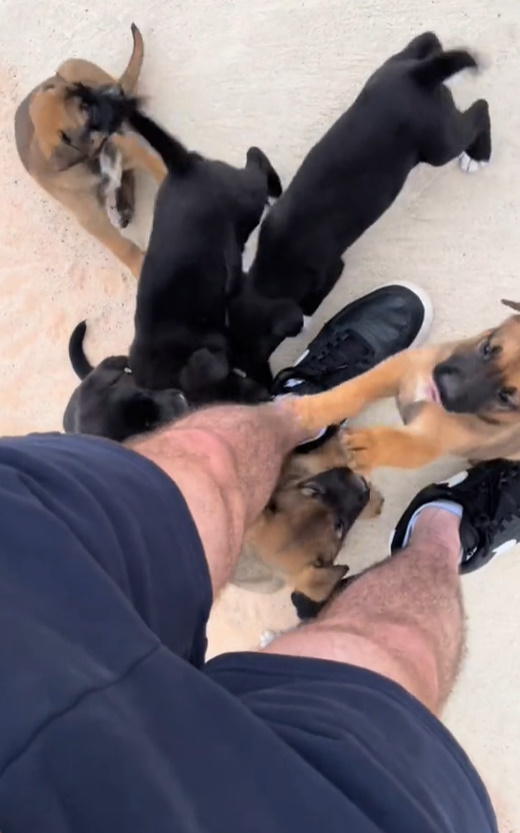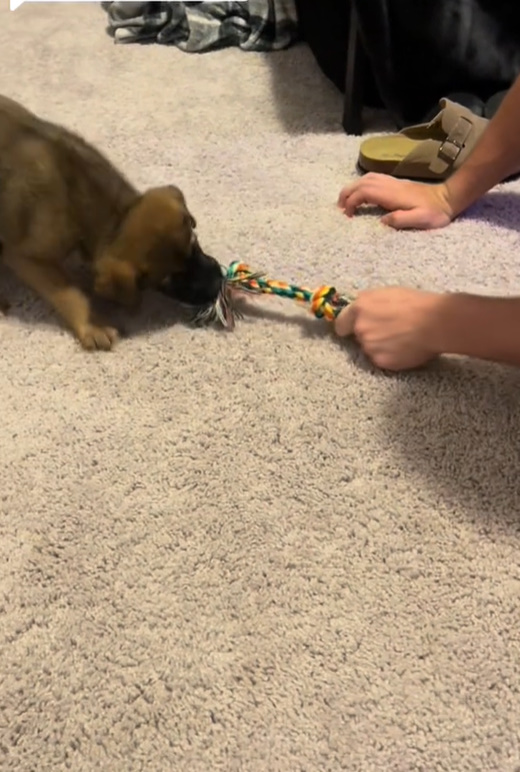Out of all the dog adoptions that happen in the world, most of them are done through shelters or some smaller rescue organizations.
But, the question arises: how many of us have heard about the ‘distribution system’? Well, it’s when a dog or a cat approaches you and politely asks to be adopted.
In Antonio’s case, he was just minding his own business when he noticed puppies waiting for him on the roadside.
Noticed By The Distribution System

The man was surprised to see there were nine of them in total. All of them were very friendly and immediately greeted him.
The dog distribution system had chosen him and he was now responsible for taking care of them, at least until he could find them all a home.
However, there was one tiny problem. He had no way of getting them all to safety since his car was at home.
So, Antonio called his friend and she arrived with her vehicle at the place where they all were.

Both of them took the puppies and carefully placed them in the car. Then, Antonio’s friend drove him home, and they placed the puppies in the yard.
They determined that there were two boys and seven girls. They were only a few weeks old, and their breed was Belgian Malinois.
They were very playful from the very moment they were taken into the house, and Antonio was surprised to see just how friendly they were.
They Have All Found Their New Homes

And, just like that, he was able to find a suitable home for all of them in a very short period of time.
Their new owners updated Antonio on their health. While they had fleas and worms, they were mostly healthy puppies.

After posting the video on the internet, it received over 18.7 million views, 3.1 million likes, and several thousand comments.
Well, if this doesn’t confirm that fact, I honestly don’t know what does. Another person commented: “WHY DOES THIS NEVER HAPPEN TO ME?”
Honestly, I wish we were all so lucky, but who knows? It might happen to any one of us at some point in our lives.

Honestly, it’s wonderful to see that there are people out there like this who will take every opportunity they have to help a puppy in need.
It never takes much – all they want is a warm home and a loving family, and we all have the power to help them find it.
Keeping your furry friend clean is essential for their health and happiness. When it comes to washing your dog, finding the right balance is key. You want them to be clean and smelling fresh, but overdoing it can strip their coat of natural oils. Figuring out the ideal frequency for bath time can be a bit of a puzzle, but fear not, we’ve got you covered.
As a seasoned dog trainer, you understand the importance of maintaining your pup’s hygiene without causing any skin issues. The frequency of baths can vary based on your dog’s breed, coat type, and lifestyle. Finding the sweet spot ensures they stay clean and comfortable without unnecessary baths that could do more harm than good. So, how often should you lather up your loyal companion? Let’s sniff out the answer together.
Importance of Dog Grooming
When it comes to your furry friend, dog grooming is essential for their overall well-being. Regular grooming not only keeps your dog looking and feeling great but also plays a crucial role in maintaining their health.
Health Benefits
Grooming your dog helps to prevent various health issues. Brushing your dog’s coat removes dirt, debris, and loose fur, preventing skin irritation and matting. Regular nail trimming ensures proper paw health and prevents painful overgrowth. Additionally, cleaning your dog’s ears and teeth helps prevent infections and dental problems.
Coat Care
Different dog breeds have varying coat types, each requiring specific grooming routines. Regular bathing, brushing, and trimming are necessary to keep your dog’s coat shiny, healthy, and free from tangles. Proper coat care also helps in distributing natural oils, promoting skin health.
Bonding Time
Grooming sessions provide an excellent opportunity to bond with your dog. It allows you to check for any abnormalities like lumps, bumps, or ticks, enabling early detection of health issues. Regular grooming helps your dog become comfortable with being handled, strengthening your relationship.
Professional Guidance
For specific grooming needs or challenges, seeking advice from a professional groomer can be beneficial. They can recommend the right products, techniques, and frequency of grooming based on your dog’s breed and individual requirements.
Conclusion
Regular grooming is more than just keeping your dog clean; it’s a fundamental aspect of responsible pet ownership that contributes to your dog’s health, comfort, and happiness. By establishing a consistent grooming routine tailored to your dog’s needs, you can ensure they look and feel their best while promoting their overall well-being.
Factors to Consider
When determining how often to wash your dog, there are several factors you should take into account:
- Breed: Different dog breeds have varying coat types and grooming needs. Dogs with longer coats or those prone to skin issues may require more frequent baths.
- Activity Level: Dogs that spend a lot of time outdoors or are more active may get dirtier faster and need more frequent baths.
- Skin Conditions: If your dog has skin conditions or allergies, your vet might recommend a specific bathing schedule using gentle shampoos.
- Smell: If your dog starts to develop a strong odor, it might be time for a bath. However, be mindful not to over-bathe, as it can strip their skin of natural oils.
- Lifestyle: Indoor dogs that stay clean and don’t have skin issues may need baths less frequently compared to outdoor dogs.
- Water Exposure: Dogs that swim frequently or get muddy often may need more frequent baths to remove dirt and prevent skin issues.
Considering these factors will help you determine how often to bathe your furry friend, keeping them clean, healthy, and happy.
General Guidelines for Washing your Dog
When determining how often to wash your dog, it’s essential to consider various factors such as breed, activity level, skin condition, smell, lifestyle, and water exposure. Here are some general guidelines to help you keep your furry friend clean, healthy, and happy:
- Breed: Different breeds have different grooming needs. Breeds with oily coats may need more frequent bathing, while those with water-resistant coats may need less frequent baths. Consult with your vet or a professional groomer to understand your dog’s specific requirements based on their breed.
- Activity Level: Dogs that spend a lot of time outdoors and get dirty frequently may need more frequent baths than indoor dogs. If your dog loves rolling in the mud or swimming, you may need to bathe them more often to keep their coat clean.
- Skin Condition: Dogs with skin issues or allergies may require special shampoos or medicated baths as recommended by your vet. Frequent bathing without the right products can worsen skin problems, so always follow your vet’s advice.
- Smell: If your dog starts to smell unpleasant, it’s a sign that they may need a bath. Regular grooming can help control odors, but if your dog has a strong smell between baths, it may be time for a wash.
- Lifestyle: Consider your dog’s daily activities. If they spend a lot of time indoors and don’t get dirty often, they may need baths less frequently. However, if they are outdoor adventurers, they may need more regular baths to maintain hygiene.
- Water Exposure: Dogs that swim frequently or are exposed to saltwater or chlorine may need baths to remove any residue that can irritate their skin. Rinsing your dog after they’ve been in the water can help prevent skin and coat issues.
Remember, while regular grooming is essential for your dog’s hygiene, over-bathing can strip their coat of natural oils and cause skin problems. Always consult with your vet or a professional groomer for personalized advice on how often to wash your dog based on their individual needs.
Signs of Over-washing
Excessive bathing can have negative effects on your dog’s skin and coat. Here are some signs that indicate you may be washing your dog too frequently:
- Dry and Flaky Skin: If you notice your dog’s skin becoming dry and flaky, it could be a sign of over-washing. Bathing too often can strip the natural oils from your dog’s skin, leading to dryness and irritation.
- Itchy and Irritated Skin: Constant scratching and skin irritation are common signs of over-washing. When the natural oils are stripped away, your dog’s skin may become itchy and sensitive.
- Dull and Brittle Coat: Over-washing can cause your dog’s coat to lose its natural shine and become dull and brittle. The lack of natural oils can make the fur appear lifeless and unhealthy.
- Increased Shedding: Bathing your dog excessively can trigger increased shedding. The loss of natural oils can disrupt the hair follicles, leading to excessive shedding and an unkempt appearance.
- Redness or Hot Spots: Over-washing can also result in redness or hot spots on your dog’s skin. These areas may be inflamed, irritated, and appear red or painful to the touch.
- Unpleasant Odor: Ironically, over-bathing can sometimes cause your dog to develop a foul odor. When the skin’s natural balance is disrupted, it can lead to an unpleasant smell despite regular baths.
If you observe any of these signs in your dog, it may be time to reduce the frequency of baths and consult a professional groomer or veterinarian for personalized advice.
Conclusion
Remember, keeping your furry friend clean is crucial for their health and happiness. Factors like breed, activity level, and skin conditions play a role in determining how often your dog needs a bath. Over-washing can lead to skin issues and a dull coat, so it’s important to find the right balance. If you notice any signs of over-washing, like dryness or itching, it’s time to adjust your bathing routine. Consult with a professional groomer or vet for personalized advice on caring for your dog’s grooming needs. By finding the right bathing frequency and grooming routine, you can ensure your dog stays clean, comfortable, and looking their best.
Frequently Asked Questions
Why is regular dog grooming important?
Regular dog grooming is essential for maintaining your pet’s overall well-being. It helps prevent health issues, keeps their coat clean and healthy, and promotes bonding between you and your furry friend.
How often should I bathe my dog?
The frequency of dog baths depends on factors like breed, activity level, skin conditions, smell, lifestyle, and water exposure. Over-bathing can lead to skin problems, so it’s crucial to find a balance based on your dog’s specific needs.
What are the risks of over-washing my dog?
Over-washing your dog can cause issues like dryness, irritation, dull coat, increased shedding, redness, and unpleasant odor. If you observe these signs, it’s essential to reduce bathing frequency and seek advice from a professional groomer or vet.
[no_toc]

Hey there, I’m Janet Brooks, a dog-loving student from California. I’m all about helping pups in need, especially those without homes. Me and my awesome friends work together to give shelter and love to stray dogs. Oh, and I also write blogs about dogs to share helpful info.